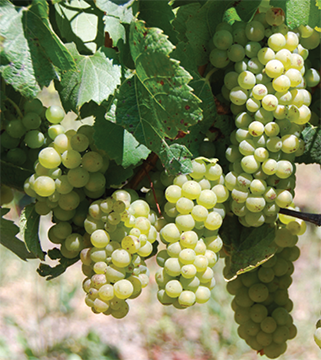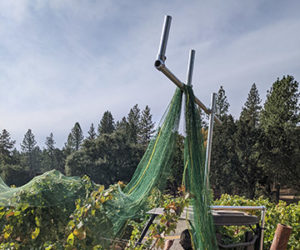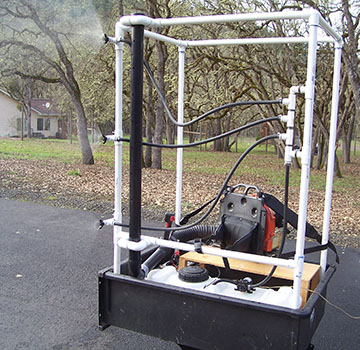 When it comes to the subject of balance in the vineyard, I want to give you as much practical information as possible to help you dial in your home vineyard (or future home vineyard) with the equilibrium necessary to grow delicious, quality wine grapes. But before we get bogged down in my own story, here’s a few opening salvos in the battle of vineyard balance:
When it comes to the subject of balance in the vineyard, I want to give you as much practical information as possible to help you dial in your home vineyard (or future home vineyard) with the equilibrium necessary to grow delicious, quality wine grapes. But before we get bogged down in my own story, here’s a few opening salvos in the battle of vineyard balance:
1. Balance in a vineyard is defined as a vine that has enough leaves to ripen a small to moderate crop load.
2. A balanced vine bears just enough fruit to make intense wine, but not so little crop as to make the ripening occur too quickly.
3. A balanced vine will allow sunlight and wind to penetrate the canopy (but not so much sun to burn the fruit) and help keep the fruit healthy and free from disease and mildew. A balanced vine is neither too stunted nor too vigorous.
4. Balance can be obtained by matching the correct vine variety and rootstock to a soil and climate. But a vineyard often needs to be touched up to encourage balance by manipulating a vine with labor, and sometimes inputs (compost, sulfur, fertilizers, etc.).
5. Many viticulturists are hesitant to give precise definitions of balance in the vineyard, but that changed in 1992 with the publication of Sunlight Into Wine by Dr. Richard Smart. Dr. Smart’s masterwork changed growing grapes in a profound way.
Spring
Spring signals budbreak and the promise of a new vintage. To achieve balance in spring, consider these tips:
• Balance cannot occur in a vineyard devastated by mildew, rot or insects.
• Plan your sprays carefully and remember that most pro grape farmers spray fungicide for the first time before
6 inches (15 cm) of new vine shoot growth.
• If you’ve had issues with mildew/rot previously, hit the vines earlier and increase the frequency of your spraying.
• The most common problem in home vineyards is lazy spraying and serious mildew damage on the fruit.
• Check your vines for double shoots. Each bud should only produce one shoot, but commonly, especially in moderate to high-vigor vineyards, two shoots will emerge from one bud. Choose the most upright, healthy, fruitful shoot and break off the extra shoot with your thumb (careful not to break both). If the vines are vigorous enough to support extra shoots, you can leave them both if they both have fruit.
• I suggest (especially in a crowded canopy) to remove all fruitless shoots at about 6–8 inches (15–20 cm) of growth. Always retain the healthiest and most fruitful shoot.
• Stunted vines can be given a small amount of a balanced fertilizer, like 15-15-15. (The first number on a fertilizer package, e.g. 15-0-0 is nitrogen. The second number is phosphorous (P) and the third number is potassium (K).)
• Especially in young vineyards, clean out the vine row (under the vines) of tall grasses and weeds. Mature vineyards can handle some weeds, but young vineyards should be kept quite tidy with bare earth beneath the vine row.
Summer
Summer is when the idea of balance in the vineyard will become critical. The best way to communicate my ideas about balance in the vineyard and how it can be obtained is to describe my own viticultural training.
In 1994 I gave up a career in public education to grow grapes. My mother and stepfather had purchased forty acres of rolling hillside near Lompoc, California and they needed someone to live on the property and watch over things. Steve Pepe, my stepfather, always dreamed of owning a vineyard, and starting in 1996 he hired the best viticultural consultant in Santa Barbara County (Jeff Newton) to plant the first half of our vineyard — 14 acres of Chardonnay. At the time Jeff was being inundated with projects, and after finishing the 14-acre planting, he moved on to larger projects, and we found ourselves lacking a vineyard manager. Jeff gave me a valuable bit of advice before he left Clos Pepe: He told me that I could easily take over the farming duties for the new vineyard, and that if I spent five years in the vineyard, I could be a great winemaker.
With that encouragement in mind, I signed up for extension courses offered by UC-Davis. In 1996 I quit public education and went to work at Babcock Vineyards and Winery in Lompoc. I was able to work in the vineyard and to assist for a full crush season with Bryan Babcock, who instilled in me a passion for vines and wine. Bryan is one of those winemakers that spends more time in the vineyard than the cellar, and it was ‘kicking the dirt around’ with Bryan when I first understood the relationship between well-tended vines and fine wine. Walking through the rows of Pinot Noir, Bryan would show me how the workers would remove leaves around the developing clusters (after bloom) to ensure the clusters would be bathed in light, and that no vegetal flavors would remain in the grapes.
Sunlight exposure on the developing clusters, he explained, was incredibly important to making the juicy, structured, complex, balanced wines he is famous for. He would instruct the workers to tuck all the shoots up into the vertical shoot-positioning wires above the vines to make sure the vines wouldn’t sprawl and shade the fruit. When finished, the vineyard rows looked like skinny, vertical solar panels, with exposed clusters on the bottom, just above the fruiting wires. A few months later, after making careful crop predictions, Bryan decided there was too much crop in the field. It was then that I participated in my first “green harvest,” or cutting one cluster off shoots that had two clusters of grapes attached. We dropped nearly half of the Pinot Noir crop on the ground that year, and the wine was much improved as a result: Darker, more intense, deeply complex. I figured in my head that at $2,500 a ton, we
probably dropped $30,000 worth of fruit on the ground that season. This was my first lesson that great winemakers have to make serious sacrifices to improve their craft and their wine.
Before harvest and crush were in full swing, I took a week off to attend UC-Davis’ three-day “Varietal Winegrape Production” course. There I found myself drowning in a stormy sea of confusing lingo (terms like inflorescense, interveinal chlorosis, and evapotranspiration) and I could see many of the would-be lawyers/doctors/farmers around me knitting their brows as well.
Three days passed slowly, and I readily admit that I fought off headaches and naps (I snuck wine into the lunches) to learn the basics of viticulture. At the end of the three days my head was swimming with facts and theory and ideas, and I was energized to get back to Clos Pepe, and spend some time in the vineyard. I understood vineyard balance in theory, but I lacked the practical skills to make it a reality at Clos Pepe.
The following season (1997) was our vineyard’s second year. The lessons I learned at Davis led me to visit the bookstore before I left and purchase the standard viticulture textbook, Dr. Richard Smart’s Sunlight Into Wine, as well as The Production of Grapes and Wine in Cool Climates by Jackson and Schuster. These books kept me company in the evenings, during the day I was a vineyard laborer. I tied growing vines to the training stakes, I hoed out vine rows, I planted replacement vines, and I began to survey, plan and order materials for the establishment of 14 acres of Pinot Noir scheduled for the following season. My life was now consumed with grape growing. The reading helped me understand what I was seeing in the vineyard, but the actual work, the calluses, the cuts, the physical handling of the vines taught me something that books cannot. It is impossible to describe in words the pressure one can exert on a growing vine shoot without snapping it. It’s impossible to describe the color of a healthy vine or the texture of a leaf that has been wind-damaged but not virused.
Here’s what I learned through this process that can be easily transferred from my brain to yours: One can describe vine balance in mathematical terms — a ratio of 15 leaves to 1 cluster is perfectly appropriate. But until you have walked a row and counted leaves and clusters on a thousand plants, it will be difficult for you to know balance just by looking at the vine and having that frame of reference. Working the vineyard every day for a year taught me more about plants and vines that any other experience in my life. It also taught me these things about our vineyard, what our vines needed, how much water our vines required, how quickly our weeds grew and which were noxious and which weren’t. In other words I became part of the environment of the vineyard, and by virtue of my proximity, understood the needs of the vineyard in a truly physical and sympathetic manner.
After working a full year in the vineyard, I went back the next year and took the “Varietal Winegrape Production” course at UC-Davis again. The same terms that made my head swim the year before now seemed simple. The detailed account of a grapevine’s physiology and growth cycle was like second nature to me now, for I had accompanied the vines through their growth cycle for a year in the field. The issues of vineyard establishment, pest management, irrigation, fertilization, etc. had become sensible and meaningful now. I cannot stress how important this process was: struggling and persevering to understand vocabulary and concepts, putting those concepts to work for an entire year of hard labor and independent study, and then returning for the exact same lectures for another three days, to reinforce what I learned and to remind me of the basic tenets of sound viticulture.
During the breaks at the UC-Davis classes I would hear a few farmers complain that the professors were not giving them ‘tricks’ to make everyone’s vineyards more profitable. The professors would repeat the same mantra at every session: ‘Viticulture is site specific!’ After attending the second set of UC-Davis lectures, I began to feel that I understood the rhythm of the vineyard season. Our vines would be ok as long as I spent time with them and listened carefully to the subtle cues they offered. Sticking to this philosophy, as years and decades passed, I went from a struggling, confused farmer to someone getting top dollar for his fruit. And there is the most important ‘trick’ of achieving balance in the vineyard: You have to care deeply about the vineyard.
Here are some of the basics of achieving balance in your backyard vineyard that I live by. (Much of this comes from Dr. Richard Smart’s Sunlight Into Wine):
Balance means that there is a ratio of about 12–15 leaves for every cluster of grapes on the vine. You need to count the leaves on as many vines as possible, then count the clusters. If there are too many leaves, try to remove shoots that bear no fruit, or hedge off the top of the shoots if they are too tall and vigorous. If there are too many clusters, remove them to make the ratio more balanced. I recommend removing the top cluster on shoots that bear two or more clusters. Don’t remove all the clusters from one shoot, leaving multiple clusters on other shoots. Balance also means giving each cluster equal vine resources to ripen. This will also help your fruit ripen evenly. If your vines continue to be too vigorous, reduce or eliminate fertilization. If there are too few leaves, think about finding a fertilizer that adds nitrogen to your soil and vines.
Balance can be measured by weighing the amount of grapes harvested off each vine at harvest, recording it, and then (later, in the dead of winter when you prune) weighing the pruned canes that you cut off (from the same vine). Keep records of both measurements, and make sure you correlate the data and use the same vine to make a ratio of grape yield (in pounds) and pruned canes (in pounds) for the same growing season. You might want to do this for at least 10-20 vines in a normal small-production/backyard vineyard, to get a fairly accurate ratio. Now look at the data as a ratio. The yield of grapes should be between 5 to 10 times the weight of the pruned, mature canes cut off the vine during pruning. For example, if you harvested 10 pounds (4.5 kg) of fruit off each vine, the pruned canes should weigh between 1 and 2 pounds (0.45 and 1 kg) off the same vine. This is a purely mathematic way of measuring balance in your backyard vineyard, and is a common practice in commercial vineyards.
The final measure of balance in your vineyard is the quality of fruit produced, and the quality of wine that results. A balanced vine allows sun to penetrate the canopy and fleck the fruit. On a sunny day, at least 10% of any given cluster should be flecked by sunlight. In cooler areas, more leaves can be removed around the fruit to further expose the fruit. The key is to find out how much sun the clusters can take without burning, cracking or raisining. Clusters exposed to sun and wind will also have lower mildew and disease pressure. It is also advisable to give each cluster their own little space on the canopy, so no clusters are ‘nested’ (touching or bunched up), and the crop load looks evenly spaced along the vine. Nested clusters are a perfect breeding ground for pest animals and disease, rot and mildew. Allowing sun to fleck and/or bathe your fruit will improve color, add flavor, and remove vegetal aromas/flavors in the resulting wine. Leaf removal is best done right after the vine has finished bloom. Check out the sidebar on the facing page for more specific balance tips.
As the UC-Davis’ instructors repeated many times, viticulture is site specific, and every vineyard has a different definition of balance. The more time you spend in your vineyard trying these techniques and cultural practices, the more you will understand what is needed to achieve balance. Good luck with your 2017 growing season. If you have questions, please don’t hesitate to reach out! Facebook: Wes Hagen, twitter: @jwilkeswines, Instagram: J.Wilkes_Wines
Vineyard Balance Tips (sidebar)
The question remains: How to achieve balance in a backyard vineyard specifically? Here are some activities to help you achieve balance in your backyard vineyard.
• Position the longer shoots up and away from the clusters (using catch wires in a trellising system if possible), remove a few leaves from near the fruit, experiment and see how much sun you can provide without burning the grapes.
• If your shoots grow so long that they droop (sprawl) back over and shade the fruit, go ahead and hedge off the tops of the vines. Be wary though. Sometimes hedging vines will cause the shoots to ‘bush out’ near the bottom. You may have to remove a few more leaves near the fruit if this occurs.
• Make the vines look tended, orderly, and your fruiting zone is open enough to get some sun and wind inside the canopy to reduce mildew and disease pressure. Watch to make sure the fruit isn’t being burned.
• Cut some crop off half your vines, make the wines from both halves separately, and taste the wines blind after they are finished, to see if crop reduction increased intensity, color, or both. Cluster removal is best done after bloom and fruit set, and before veraison, or when the grapes turn soft.
• Keep a hand’s width between growing shoots, and remove stunted shoots altogether. If the canes are too crowded with small shoots, or shoots that bear no fruit, remove those fruitless/stunted shoots to make more room for the good shoots to grow.
• Remove basal shoots or ‘suckers’ (shoots that grow from the bottom of the vine or not out of a ‘bud’ that you left for shoot development). You can do this by ripping them off by hand (a good downward yank usually works), cutting them off with pruning shears, or if you’re really good, with the toe/side of your shoe/boot as you walk down the rows.
• Experiment and take time to learn from your vineyard, listen to what the vines have to say through the finished wine. If there’s a specific problem in the wine, and you are sure your cellar practices are sound (wines stay stable, clean, barrels/containers are topped weekly, etc.) try to find a way to balance your vineyard to produce better fruit.
• If the wines are vegetal/herbal, remove a few more leaves. Be careful not to take so many that you burn the fruit. Experiment and take notes on how many leaves can be safely removed in your climate zone. Cooler/foggier weather can remove more leaves, in hot areas (or even heat waves) you need to leave some shade for the hottest parts of the day.
• If the wines lack intensity, try to leave less fruiting wood on the vine at pruning (reduce the crop) while keeping the vine in balance.







